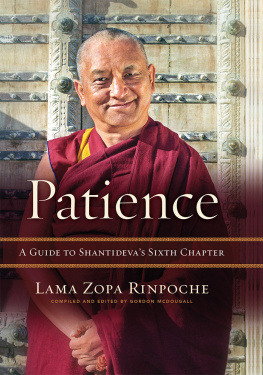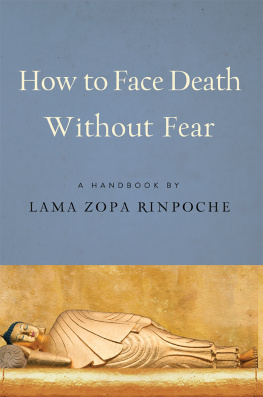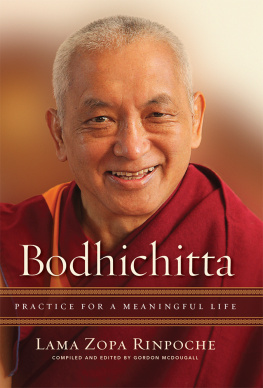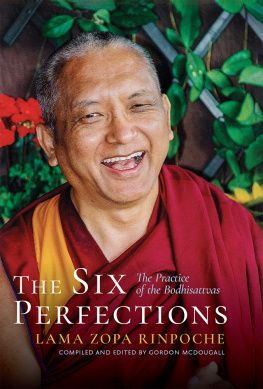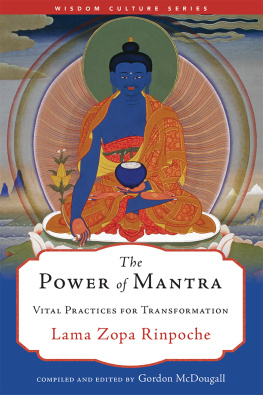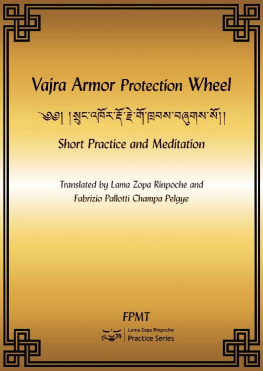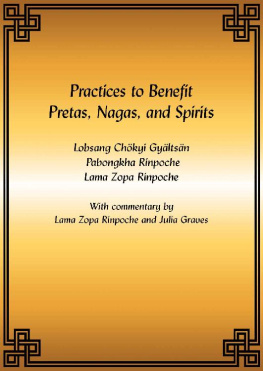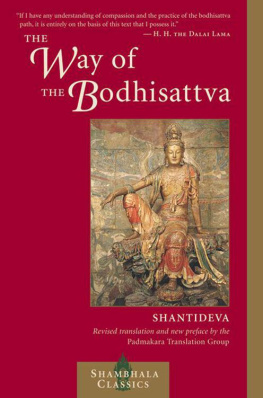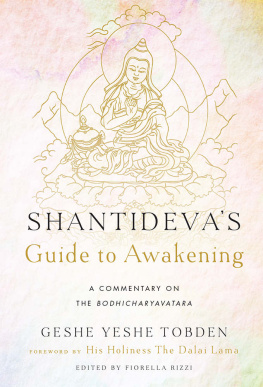
Wisdom Publications
199 Elm Street
Somerville, MA 02144 USA
wisdomexperience.org
2020 Lama Thubten Zopa Rinpoche
All rights reserved.
No part of this book may be reproduced in any form or by any means, electronic or mechanical, including photography, recording, or by any information storage and retrieval system or technologies now known or later developed, without permission in writing from the publisher.
Library of Congress Cataloging-in-Publication Data
Names: Thubten Zopa, Rinpoche, 1945 author. | McDougall, Gordon, 1948 compiler, editor.
Title: Patience: a guide to Shantidevas sixth chapter / Lama Zopa Rinpoche; compiled and edited by Gordon McDougall.
Description: Somerville, MA: Wisdom Publications, 2020. | Includes bibliographical references and index.
Identifiers: LCCN 2020001721 | ISBN 9781614296416 (hardcover) | ISBN 9781614296423 (ebook)
Subjects: LCSH: ntideva, active 7th century. Bodhicaryvatra. Chapter 6. | Patience Religious aspects Buddhism. | Mahayana Buddhism Doctrines.
Classification: LCC BQ3147 .T54 2020 | DDC 294.3/5 dc23
LC record available at https://lccn.loc.gov/2020001721
ISBN 978-1-61429-641-6 ebook ISBN 978-1-61429-642-3
24 23 22 21 20
5 4 3 2 1
Cover photo by Lenny Foster. Cover design by Marc Whitaker. Interior design by Gopa & Ted2. Typeset by Tim Holtz.
Printed in Canada.
EDITORS PREFACE
W HEN I was compiling Lama Zopa Rinpoches teachings for The Six Perfections, the chapter on patience presented a major problem: it became longer and longer. This was obviously Rinpoches favorite perfection to teach on. (His name, Zopa, does mean patience, after all.)
The chapter needed serious paring down so that it wouldnt overwhelm the other chapters, but the teachings Rinpoche has given on patience are not just vitally important but also wonderful. When we looked to see if having a separate book just on patience would work, we realized we could structure it around the sixth chapter of Shantidevas A Guide to the Bodhisattvas Way of Life.
Rinpoche had actively taught on many of the verses of that chapter in the early Kopan courses, but there were sections he had not specifically covered. However, when I searched for teachings related to those verses, I was pleased to find nearly perfect matches. If you find that in a few places the commentary does not exactly reflect the content of the verses, I apologize. Probably, somewhere in Lama Yeshe Wisdom Archives vast store of transcripts from Rinpoches teachings, there are perfect ones, but I was unable to find them. Fortunately, these are very few, and mostly it is as if Rinpoche and Shantideva are of one mind. It was a joy to discover, as I compiled the book, that here was a complete commentary on this crucial chapter of one of the most important books in Tibetan Buddhism that also encompassed the quintessence of Rinpoches teachings.
This has been a delight to edit. Long my favorite Buddhist text, I have read A Guide to the Bodhisattvas Wayof Life many times, but working through the sixth chapter in order to compile this book has meant exploring it in a depth that simple reading doesnt allow. My hope is that, because each small block of verses is the core of a teaching by Rinpoche, you too can have the taste of going deeper into this profound and very beautiful text.
We have chosen to use the translation by Luis Gmez, from his Introduction to the Practice of the Bodhisattva (Wisdom Publications, forthcoming). With the publishers permission, we have changed his prose translation into verse, as thats how the text traditionally appears. Other texts quoted have been cited.
So many people have worked so hard to make this book a reality. Not just the team at Wisdom Publications, and specifically Laura Cunningham, who I worked closely with, but also all the staff and volunteers who work for Lama Yeshe Wisdom Archive, painstakingly recording, transcribing, and archiving all of Lama Zopas courses. I want to thank them all for helping to spread Rinpoches words words that are absolutely vital in this very fractured world.
I apologize for any errors found in this book; they are 100 percent mine. May this book inspire people to turn away from anger and selfishness and develop patience and compassion. May whatever merits gained from the creation of this book be dedicated to peace in this world, to the long life, well-being, and fulfillment of the wishes of all our holy teachers, especially His Holiness the Dalai Lama and Lama Zopa Rinpoche, and to the flourishing of the Foundation for the Preservation of the Mahayana Tradition and of the Dharma throughout the world.
Gordon McDougall
Bath, UK
INTRODUCTION
THE THIRD PERFECTION
Patience is the third of the six perfections, which are practices to ripen the mind of the bodhisattva:
Charity (dana)
Morality (shila)
Patience (kshanti)
Perseverance (virya)
Concentration (dhyana)
Wisdom (prajna)
The nature of patience is keeping the mind in virtue whenever we encounter disturbance and harm. We, of course, could endure these with a nonvirtuous mind as well, which is why the distinction is made. There are three types of patience:
the patience of accepting suffering
the patience of disregarding the harm done by others
the patience of having certainty in the Dharma
Besides learning to not harm those who try to harm us and having patience when we are faced with suffering, we must have certainty in the Dharma and persevere no matter what hardships may arise when we try to practice it. There will certainly be hardships, but we must never forsake the Dharma, no matter how difficult it becomes. Without this strong determination, there will be little progress, and we can easily become lazy and waste our precious human rebirth.
The sixth chapter of Shantidevas Guide to the Bodhisattvas Way of Life (Bodhicharyavatara), the chapter on patience, is an extraordinary teaching on what patience is and how to develop it. In this book, we will use his entire chapter to explore the perfection of patience.
I also recommend that you read the ninth chapter, the chapter on wisdom, which complements the understanding of the advantages of patience with how things are dependent arisings and empty of inherent existence. Patience and wisdom together are the best cure for the delusions that are causing us suffering now.
SHANTIDEVA
Shantideva was born in the eighth century CE in India, near Bodhgaya, where the Buddha was enlightened. the manifestation of all the buddhas wisdom, and not only saw Manjushri but also had a realization of him. Manjushri himself gave the young Shantideva many teachings, passing down the lineage of the profound path the wisdom teachings to him.
Because Shantideva was a prince, he was obliged to become king when his father died, but the night before the enthronement he had a dream. Manjushri was sitting on the kings throne, and he said to Shantideva, The one son, this is my seat and I am your guru, leading you to enlightenment. We cant both sit on the same seat. When he awoke from the dream, he realized that he could not accept the crown, where the abbot ordained him, naming him Shantideva.
Nalanda was a vast and wonderful place, the greatest seat of Buddhist knowledge in the world. Thousands of scholars studied, debated, and meditated there, and great pandits wrote incomparable treatises and developed incredible tenets on logic, as well as studied the sciences, art, medicine, and so forth. I can imagine that Nalanda was a very busy and vibrant place, and yet, outwardly, Shantideva appeared to do absolutely nothing. While the other monks studied, debated, prayed, did prostrations, engaged in debates, and did all the jobs around the monastery that were needed, Shantideva appeared to do none of these. The other monks could see none of his inner qualities and they became quite contemptuous of him, calling him
Next page
